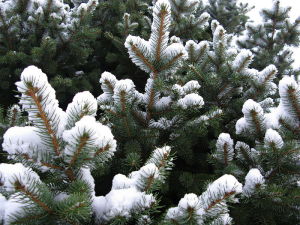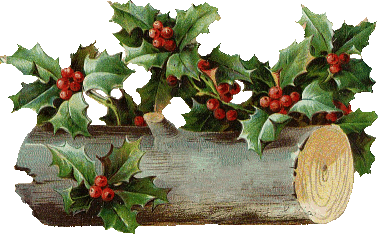From Christmas trees to mistletoe, nature is a central part of modern traditions during winter solstice. Their origins, however, lie in pagan celebrations of the return of the sun, the lengthening of the days, and anticipation of a new harvest season.
Evergreen Trees
 Druid legends say that in a time before man, the sun went on a journey, and asked the trees to remain awake and watch for him. Initially, all the trees agreed, but over time the trees began to fall asleep. First the maples, then the birch and ash trees, and finally the oaks. When the sun returned, only the pine and fir trees remained. The sun rewarded the pines and firs with life year-round, and thus, evergreen trees were formed. Their continuous greenery represents the persistence of life through the winter.
Druid legends say that in a time before man, the sun went on a journey, and asked the trees to remain awake and watch for him. Initially, all the trees agreed, but over time the trees began to fall asleep. First the maples, then the birch and ash trees, and finally the oaks. When the sun returned, only the pine and fir trees remained. The sun rewarded the pines and firs with life year-round, and thus, evergreen trees were formed. Their continuous greenery represents the persistence of life through the winter.
Juniper Wreaths
 Witches are bound by fairy law to count all the leaves on juniper plants they encounter. During solstice and equinox, when the barrier between worlds is diminished and witches and spirits are most likely to be roaming the living world, people hung juniper on their doors, hoping the witches would bypass their house to avoid counting the tiny leaves. Wreaths made of juniper and other evergreens symbolized the light and protection of the sun.
Witches are bound by fairy law to count all the leaves on juniper plants they encounter. During solstice and equinox, when the barrier between worlds is diminished and witches and spirits are most likely to be roaming the living world, people hung juniper on their doors, hoping the witches would bypass their house to avoid counting the tiny leaves. Wreaths made of juniper and other evergreens symbolized the light and protection of the sun.
Yule Log
 Yule logs burned in homes to protect them from witches and celebrate the return of the sun as the days finally begin to lengthen once again. Often the logs were soaked in water to extend their burning time. Adding holly or mistletoe to the fire burned away grumpy thoughts. Traditionally, ashes from the log were spread on the fields in the spring to encourage soil fertility.
Yule logs burned in homes to protect them from witches and celebrate the return of the sun as the days finally begin to lengthen once again. Often the logs were soaked in water to extend their burning time. Adding holly or mistletoe to the fire burned away grumpy thoughts. Traditionally, ashes from the log were spread on the fields in the spring to encourage soil fertility.

